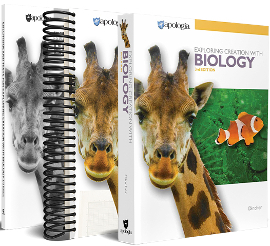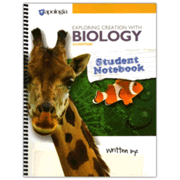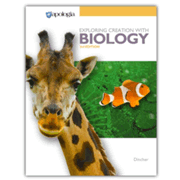Exploring Creation with Biology, 3rd edition, is part of Apologia’s series of college-prep lab science courses for junior and senior high. This course has been extensively revised and updated since I reviewed the first edition which was authored by Jay Wile and Marilyn Durnell. It’s better than ever! As you might guess from the title, this course is written from a Christian worldview.
The course is divided into 16 modules, and it should take about 34 weeks to complete. The number of lab experiences per module varies from one to five, with the exception of the module on evolution, which has none. Students can work independently, although it might be more practical to meet with a group class for the lab work.
The main course components are the 710-page, softcover student textbook; the 553-page, spiral-bound student notebook; a solutions and tests book for the teacher (with all answer keys); and a tests book for the student. Audio learners might appreciate the optional audiobook (MP3 CD) version of the textbook, although they will still need the printed textbook to see illustrations, lab instructions, and chapter study guides. Another helpful supplement is the optional USB thumb drive with video lectures that correlate with the lessons in the textbook. Sherri Seligson presents these lectures accompanied by visual animations and on-location video clips. The thumb drive also has videos of all of the experiments so students can see how to do them at home.
Students who work better in a class group might want to enroll in one of the Apologia Academy online courses that have real-time sessions with classmates and an instructor. Prerecorded classes are also available to use on the student's own schedule without class or teacher support.
Apologia also offers Self-Paced courses, their online option that includes the textbook in an online format, the audiobook, and the video instruction. All of the On Your Own and Study Guide questions are automated. Exams are taken online and graded by the program.
Course Content
Like many biology courses, Exploring Creation with Biology presents topics beginning with the smallest atomic elements and moves up through cells, genes, chromosomes, prokaryotes, viruses, protists, and fungi to plants and animals. Human beings are studied only as part of the class of mammals. (Apologia has a separate course that studies only the human body.)
The first two modules lay the groundwork with lessons on topics such as the scientific method, microscopes, atomic structure, molecules, compounds, chemical bonds, carbon compounds, proteins, enzymes, and nucleic acids. Chemistry will be incorporated into the discussion of many topics in this course, but it is presented at a level appropriate for those who have not had a prior chemistry course.
The third module is the exception to the “small to large” organization of the course. It makes connections between chemistry at the smallest level and large biomes, populations, and communities at the largest level. In that module, students learn about topics such as energy and life, ecological pyramids, food chains, and the biosphere (including the cycles for water, carbon, oxygen, nitrogen, and phosphorus).
The next four modules address cells, DNA, proteins, genetics, and related topics. This leads directly into the eighth module on evolution, where cellular structure and microbiology are crucially important. While the course discusses evolutionary assumptions, it primarily provides evidence against evolution.
The ninth module continues with prokaryotes and viruses, while the tenth module teaches about protists and fungi. The next two modules are on plants, and the last four modules cover animals.
Components
The student textbook has full color throughout plus many more illustrations than in the previous editions. It addresses itself directly to the student, often using a conversational style of writing.
Sets of one to four "On Your Own" questions appear periodically within each module for students to check their understanding as they go. The questions are often thought-provoking rather than just requiring the recall of information. Suggested answers to these questions are included at the end of each module. Call-outs within the modules labeled “Signs of Life,” “Creation Connection,” and “Think About This” make connections to God as designer, and they also challenge students to think more deeply about topics such as climate change.
Lab work is also included within the modules at points where they connect with the information being taught. There is no disconnect between lab activities and what students are reading in the text as is sometimes the case with lab courses. Lab work includes microscope labs, dissections, and labs using mostly household items. However, students will need a microscope, prepared and blank slides, a graduated cylinder, a dissection kit, dissection specimens, methylene blue stain, and iodine. (Apologia sells everything you need other than the household items.) A complete supply list is in an appendix at the back of the student textbook.
Each module concludes with a study guide that is meant to serve as a pretest. Students are allowed to answer questions with an open book. The study guides are two to four pages in length and present questions in different formats. They do a thorough job of reviewing key content from each module.
Both the module tests and quarterly tests are in both the teacher and student test books. The tests are generally briefer than the end-of-module study guides. Answer keys for the study guides, as well as for all of the tests, are in the Solutions and Tests book. This book also has some very brief information for the parent about course administration and grading.
The Exploring Creation with Biology Student Notebook should be a huge time saver for both student and parent. If you don't want to use it, students can work with only the textbook and create their own notebook rather than using the printed student notebook.
The student notebook has brief instructions on how to take notes using the Cornell system, then it includes pre-formatted pages for students to use to write their own notes for each module. It has the On Your Own questions and the study-guide questions from the textbook with space for students to write their answers. The last third of the student notebook briefly explains how to do lab reports and use microscopes, then reprints the complete instructions for each lab (just as they are in the textbook). Lab instructions are followed by formatted pages for writing and drawing all that is required for each experiment. By using the student notebook, students save a lot of time that would be required for drawing the charts and circles or other ways to format their data presentation. In addition, the student notebook keeps all student work other than tests together in one place. This makes it easier for parents to check student work.
Summary
Exploring Creation with Biology is a practical choice for many homeschoolers because it was created for homeschooling teens, many of whom need to work independently. The content is also thorough and up to date, providing a solid foundation for college-bound students.












